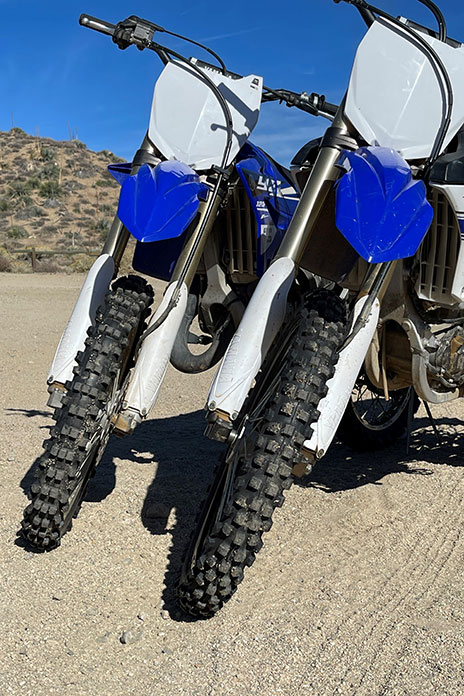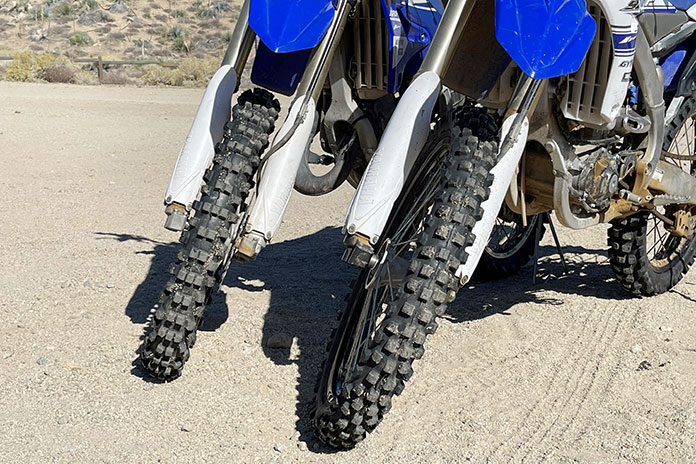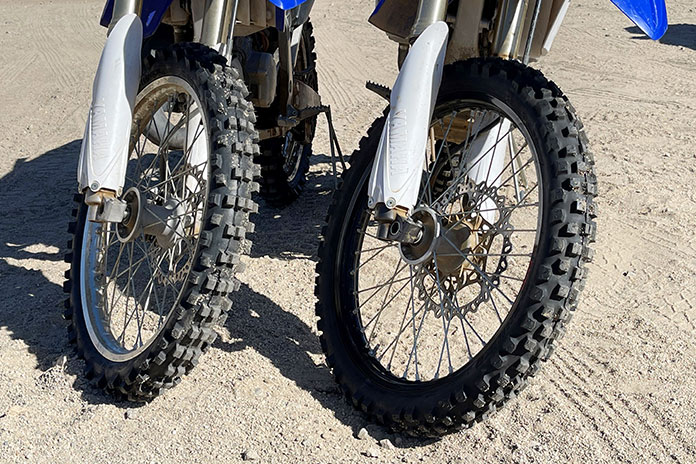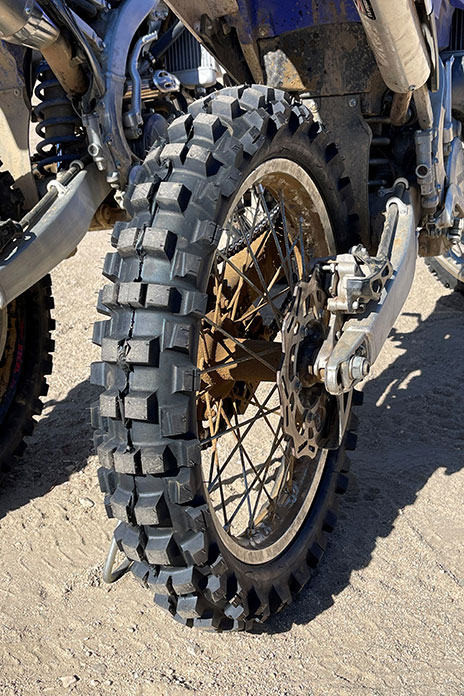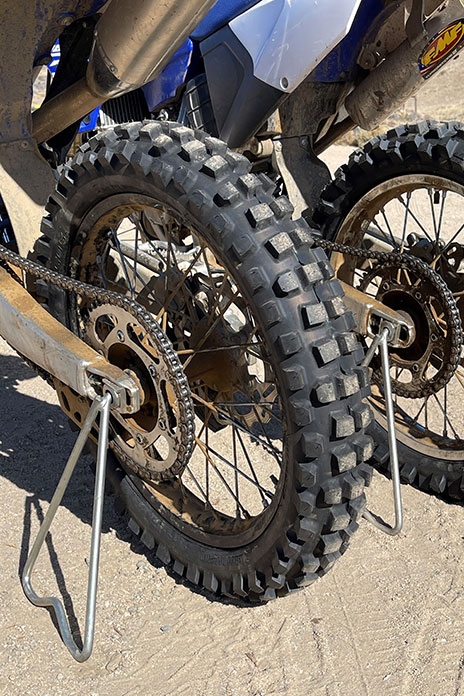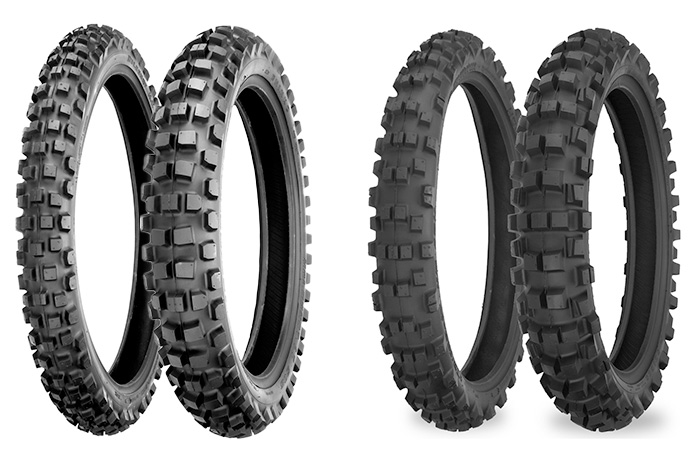
Go to any track day with a sportbike, and it’s all about lap times – and tires. There are supersport tires, racing slicks and race compounds, tire warmers and laboratory-grade pressure gauges, and mandatory tech inspections. Grip means everything – and on asphalt that is better than any public road in the galaxy. Control, control, control.
So what’s up with us dirt donks? A track day at the local MX park has no tech inspections, but the rough-and-tumble flyboys (and flygirls) go about their berm-slaying and seat-bouncing with equal zest to their roadie counterparts – and typically with less focus on tires. Serious dirt guys and racers keep their rubber fresh, of course, but for us commoners, the adage is, “If the knobs aren’t too worn, they’re good to go.” Just air ‘em up, lube the chain, and hit it, Mitch.
Well, I’m here to tell you that tires are just as crucial for dirt work as they are for the street or track. Old knobbies – compromised by time, wear, and exposure to sunlight and ozone – harden, losing their elasticity and ability to conform to the terrain. And with wear, they lose needed tread depth and the sharp edges crucial for gripping the infinitely variable and always changing Mother Earth.
Enter the Shinko off-road tires for hard and soft terrain. I wanted to ride both formulas back-to-back to learn the real-world differences between the compounds in real time. I selected the hard terrain 504 front ($84) and 505 rear ($115) tires for a late-model Yamaha YZ250F and the soft and intermediate terrain 524 front ($92) and 525 rear ($115) tires for a late-model Yamaha YZ125. The rationale was simple: Making less power, the light YZ125 2-stroke would be easier on soft tires than the heavier and gruntier 4-stroke YZ250F. Sizes were 80/100-21 front and 100/90-19 rear in both cases.
See all of Rider‘s Shinko coverage here.
The Shinko off-road 504/505 tires for hard terrain have a firm rubber compound and sturdy, closely spaced knobs. In contrast, the softer 524/525 pair features much more pliable rubber and slightly smaller knobs, with 28% wider spacing in between. Think of the hard-terrain tire like a running shoe for the Leadville ultramarathon and the soft-terrain tire like a gummy rock-climbing shoe for El Capitan. One shoe is a brute; the other is a technician.
Acknowledging that the YZ250F and YZ125 are completely different machines with different suspension systems, I evened the playing field as much as possible with stock suspension settings and by airing all tires to a uniform 14psi. My ride day included everything from sand washes to hard pack, from rocks to silt, with endless hill-climbs and an MX track thrown in.
The hard Shinko 504/505 is a tough tire; it rides firmly – perhaps even harshly – with no squirrely traits. As expected, the crisp edges of the knobs bite well – and happily, vastly better than the worn OE knobs that I replaced. Importantly, the good grip extends to the side knobs, which helps immensely when cornering, especially on the hard pack characteristic of California. For under $200 per pair, these represent a good value, especially if the MO is to run tires as long as possible.
The Shinko off-road 524/525 duo for soft/intermediate terrain rides comfy. The markedly softer rubber and breathier spacing between knobs lend a more civilized feel to these units, and the tires’ ability to conform to the conditions I encountered inspired me to dub them the “Cadillac of Shinko knobbies.” They added an extra dose of fun to the ride experience in sand and loam simply due to the pliable carcass and broad knob spacing. But they felt somewhat squirmy on hard pack and rocks.
See all of Rider‘s tire reviews here.
I would say the Shinko off-road 504/505 is a solid, long-wearing pair that will handle a wide range of conditions and take abuse over a prolonged period. They would not be my first choice for mud or deep sand particularly, but I’d jump on them for rock crawling in the Rockies or scrambling over the Mojave Road. I’d also experiment with lowering pressures to 11-12psi on local rides. Then I’d totally take the 524/525 combo for slogging through deep loam, bogs, and beachheads, where paddle-like grip is key and wear is not a factor.
And finally, a surprise: At day’s end, the 524/525 pair already displayed noticeable wear on the leading edges of the rear knobs, while the harder 504/505 pair held up better, despite their fitment on a more powerful bike. As such, in my SoCal riding universe, I figure on replacing the 524/525 units well before the 504/505 twins need renewal. But that’s okay – after all the tire swapping for this test, I’m fine-tuned with the tire irons.
The post Shinko Off-Road Tires for Intermediate and Hard Terrain | Gear Review appeared first on Rider Magazine.
Source: RiderMagazine.com

